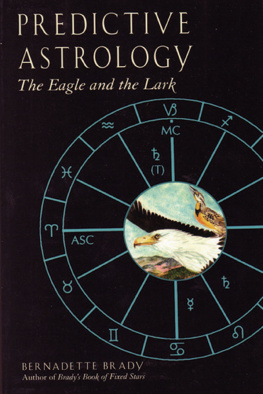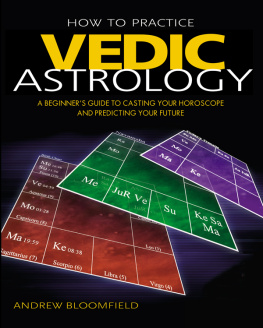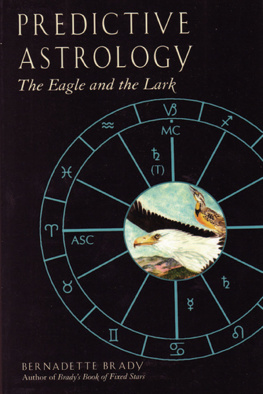ACKNOWLEDGMENTS
To write a book takes a large amount of support, encouragement and patience. For providing this, as well as endless editing, my deep thanks go to Darrelyn Gunzburg.
For the making of gallons of tea, while endlessly proofreading, my thanks go to Ysha De Donna.
And thanks to my white-haired old friend Robert.
APPENDIX 1
CALCULATING SECONDARY PROGRESSIONS
The principle of Secondary progressions is that each day after your birth is equivalent to one year of your life.
Using a Midnight or Noon Ephemeris
Pretend that you are born at Midnight (0 hours) GMT. (If using a Noon Ephemeris, pretend that you are born at Noon GMT) on January 1, 1950.
The positions, as listed in the ephemeris, on the 1st of January would be the natal positions of your planets, luminaries, and so on. On January 2nd, the position of the planets, as listed in the ephemeris, would be the exact position of your secondary progressed planets for your 1st birthday or the beginning of your second year of life.
If we leap to January 10, 1950, the position of the planets and luminaries, as listed in the ephemeris, will be the position of your secondary progressed planets on your birthdaythe beginning of your 10th year of life. Remember, every day in the ephemeris is a year in your life.
The daily movement of the planets and luminaries is shown as the difference in the positions at midnight (or noon) on the 10th of January to the midnight (or noon) of the 11th of January. That movement represents the movement of your secondary progressed planets between your 9th birthday (January 1, 1959) and your 10th birthday (January 1, 1960) because it represents the movement of the planets from your ninth day after birth to your tenth day after birth. See .
These progressed planets can be compared back to your natal chart by aspecting.
As shown in the ephemeris, the progressed planets do not remain stationary (unless they are actually making a station shown). During the course of the day (January 10, 1950) they will be movingthe Moon quite rapidly, the Sun only about a degree and the other planets at their own different rates. This 24 hour movement, is stretched out and becomes the movement .
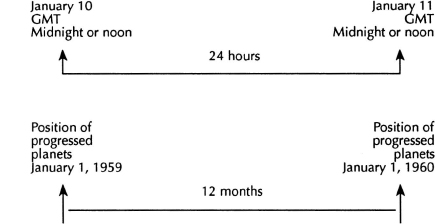
Figure 52. A day for a year method.
So, since there is this movement, the secondary progressed planets and luminaries will move in and out of orb and form aspects back to your natal chart.
It is important that you know precisely when, in a given year, that the progressed Moon, or any other progressed body, is going to be forming exact aspects to the natal chart.
For example, we subtract the position of the Moon on January 10, 1950, from the position of the Moon on January 11, 1950, and armed with this information, we can find out how much the Moon has moved over the course of the day. This movement is the movement of the secondary progressed Moon from the birthday in 1959 to the birthday in 1960.
Using a Midnight emphemeris, the lunar positions are:

Thus, the movement of the secondary progressed Moon from the 9th birthday (January 1st) in 1959 and the 10th birthday (January 1st) in 1960 is 13 59' 07.
We now take this progressed Moon's motion and divide it by 12, to obtain the monthly rate of movement for the progressed Moon between January 1, 1959 to January 1, 1960.
| Yearly movement of progressed Moon = | 13 59' 07 |
| 12 months in a year = | 12 |
In this example, the Moon's monthly movement is 1 09' 56. So, continuing with the above example, your progressed Moon on your 9th birthday is 0 30' 05 Libra (actually, the position of the Moon at midnight on January 10,1950, in the ephemeris). If you are using a noon ephemeris, substitute the noon figures. So, the progressed Moon's rate of motion per month is 1 09' 56. One month later, on February 1, your secondary progressed Moon will be:

The progressed Moon on March 1 (don't worry about the differences in lengths of the months) will be:

Continue in this fashion, adding the lunar monthly motion to the previous month's position to obtain the monthly positions of the progressed Moon as follows:
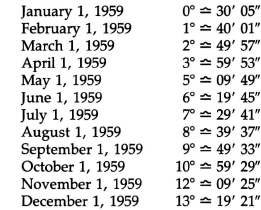
These progressed Moon positions can be compared back to the natal chart to find out when certain aspects are going to be made. The other progressed planets will be moving at a much slower rate than the Moon, so it is not normally necessary to compile a monthly table for them.
If, in our above example, the person had been born instead at Midnight GMT (or Noon) on July 17,1950, then we could find the position of the planets ten days after birth (July 27, 1950), calculate the movement, divide the movement by 12 to find the monthly movement and then construct a table starting from July 17, then going to August 17, September 17, and so on.
Thus, if you were lucky enough to be born at midnight GMT (or noon GMT if using a Noon ephemeris) you could take the planetary positions as given in the ephemeris and read them as the secondary progressed planets for your birthday in any given year you were examining: 20th year of life, equals 20th day after birth, and so on.
Very few of us are born at exactly midnight GMT (or noon GMT). Most of us are born at some other time.
The Adjusted Calculated Date or ACD
If we took our GMT birthtime and calculated the position of the planets for the GMT on a particular date being examined for progression, i.e., the 20th day after birth, and so onin exactly the same manner as if you were constructing a new natal chart, pretending that you were born 20 days laterthen the progressed position of the planets would be for your birthday in your 20th year of birth. You could then do the same process for the 21st day after life, find the difference between the first set of progressed planetary positions and the second, divide those by 12 to get the monthly movement and construct the table as given above.
Planets calculated for the GMT of your birth on a prescribed day after your birth will always equate to your exact secondary progressed planets on your birthday of that particular prescribed year.
In , the 24 hours from one midnight (or noon) to the next is symbolized by the length of the top line. By the principle of secondary progressions, one day (24 hours) represents one year of your life. The second line represent one year in your life. The point on the 24 hour line which is your GMT of birth is equivalent to your birthday on the second line.
What would be the calendar date on the bottom line that the midnight (or noon) which would be equivalent to birth GMT? If we knew this date in the year then we could look up the midnight (or noon) position from ephemeris and the positions of the planets would be the exact progressed planets for that date in any given prescribed year. The position of the planets at midnight (or noon) for the following day would be the exact secondary progressed planetary position for that date in the following year, and so on.
Next page
